Articles
- Page Path
- HOME > Korean J Community Nutr > Volume 21(1); 2016 > Article
-
Research Article
- Factors Related to Eating Habits and Nutrition Status of Mother Affecting on Body Mass Index of Children aged 1-5years: Data from the Fifth Korea National Health and Nutrition Examination Survey, 2010-2011
-
Miyeon Park, Pilsook Park

-
Korean Journal of Community Nutrition 2016;21(1):102-111.
DOI: https://doi.org/10.5720/kjcn.2016.21.1.102
Published online: February 29, 2016
1Department of Food & Nutrition, Gyeongsang National University, Jinju, Korea.
2Department of Food Science & Nutrition, Kyungpook National University, Daegu, Korea.
- Corresponding author: Pilsook Park. Department of Food Science and Nutrition, Kyungpook National University, 80, Daehakro, Bukgu, Daegu, 41566, Korea. Tel: (053) 950-6236, Fax: (053) 950-6229, pspark@knu.ac.kr
Copyright © 2016 The Korean Society of Community Nutrition
This is an Open-Access article distributed under the terms of the Creative Commons Attribution Non-Commercial License (http://creativecommons.org/licenses/by-nc/3.0/) which permits unrestricted non-commercial use, distribution, and reproduction in any medium, provided the original work is properly cited.
- 565 Views
- 2 Download
- 8 Crossref
Abstract
-
Objectives
- The intention of this study was to find out the impact of mother's body mass index, eating habits, nutrition status and sociodemographic factors on the body mass index of the children.
-
Methods
- The study used original data of Korea National Health and Nutrition Examination Survey (2010-2011) and had 957 children in the ages of 1-5 years and 957 mothers of these children, a total 1,914 as subjects. The weights (body mass indexes) of the children, subjects under 5th percentile were classified into a underweight group, 5~84th percentile into a normal weight group, 85-94th percentile into an overweight group and more than 95th percentile into an obesity group based on the 2007 Korean children and adolescents growth chart.
-
Results
- We observed that when the body mass index of a mother increased by 1, the possibility that her child would belong to the overweight group increased by 6.5% (95% confidence interval: 1.01~1.13), and the possibility that the child would belong to the obesity group increased by 95% (confidence interval: 1.01~1.18). With regard to the number of deficient nutrients which were ingested according to estimated average requirements (EAR) amid nutrients ingested by the mother increased by 1, the possibility that the child would belong to the obesity group increased by 16.6% (95% confidence interval: 1.01~1.35). In case the birth weight of child increased by 1kg, the odds ratio that the child would belong to the obesity group was 2.022 (95% confidence interval: 1.08~3.77).
-
Conclusions
- We conclude that the body mass index, eating habits and nutrition status of the mother had significant effects on the body mass index of the child. Therefore, it is critical to recognize the importance of this observation and provide practical training for eating habits and nutrient intakes in order to achieve healthy growth and prevention of obesity among children.
Acknowledgments
Acknowledgments
- 1. Matheson D, Spranger K, Saxe A. Preschool children's perceptions of food and their food experiences. J Nutr Educ Behav 2002; 34(2): 85-92.ArticlePubMed
- 2. Ministry of Health and Welfare. Korea Health Statistics 2013: Korea National Health and Nutrition Examination Survey [KNHANES VI-1] [internet]. 2014; cited 2015 Nov 10]. Available from: https://knhanes.cdc.go.kr/knhanes/index.do.
- 3. Gallagher D, Visser M, Sepulveda D, Pierson R, Harris T, Heymsfield SB. How useful is body mass index for comparison of body fatness across age, sex, and ethnic groups? Am J Epidemiol 1996; 143(3): 228-239.ArticlePubMed
- 4. Moon JS, Lee SY, Nam CM, Choi JM, Choe BK, Seo JW. 2007 Korean National Growth Charts: review of developmental process and an outlook. Korean J Pediatr 2008; 51(1): 1-25.Article
- 5. Garn SM, Clark DC. Trends in fatness and the origins of obesity Ad Hoc Committee to Review the Ten-State Nutrition Survey. Pediatrics 1976; 57(4): 443-456.PubMed
- 6. Koziel S, Kolodziej H. Birth order and BMI in teenage girls. Coll Antropol 2001; 25(2): 555-560.PubMed
- 7. Aull JL, Rowe DA, Hickner RC, Malinauskas BM, Mahar MT. Energy expenditure of obese, overweight, and normal weight females during lifestyle physical activities. Int J Pediatr Obes 2008; 3(3): 177-185.ArticlePubMed
- 8. Bandini LG, Schoeller DA, Cyr HN, Dietz WH. Validity of reported energy intake in obese and nonobese adolescents. Am J Clin Nutr 1990; 52(3): 421-425.ArticlePubMed
- 9. Sekine M, Yamagami T, Handa K, Saito T, Nanri S, Kawaminami K. A dose-response relationship between short sleeping hours and childhood obesity: results of the Toyama Birth Cohort Study. Child Care Health Dev 2002; 28(2): 163-170.ArticlePubMedPDF
- 10. von Kries R, Toschke AM, Wurmser H, Sauerwald T, Koletzko B. Reduced risk for overweight and obesity in 5-and 6-y-old children by duration of sleep-across-sectional study. Int J Obes Relat Metab Disord 2002; 26(5): 710-716.ArticlePubMedPDF
- 11. Gallaher MM, Hauck FR, Yang OM, Serdula MK. Obesity among Mescalero preschool children. Association with maternal obesity and birth weight. Am J Dis Child 1991; 145(11): 1262-1265.ArticlePubMed
- 12. Oken E, Taveras EM, Kleinman KP, Rich-Edwards JW, Gillman MW. Gestational weight gain and child adiposity at age 3 years. Am J Obstet Gynecol 2007; 196(4): 322.ArticlePMC
- 13. Gillman MW, Rifas-Shiman SL, Camargo CA Jr, Berkey CS, Frazier AL, Rockett HR. Risk of overweight among adolescents who were breastfed as infants. JAMA 2001; 285(19): 2461-2467.ArticlePubMed
- 14. Toschke AM, Vignerova J, Lhotska L, Osancova K, Koletzko B, von Kries R. Overweight and obesity in 6- to 14-year-old Czech children in 1991: protective effect of breastfeeding. J Pediatr 2002; 141(6): 764-769.ArticlePubMed
- 15. Li L, Parsons TJ, Power C. Breast feeding and obesity in childhood: cross sectional study. BMJ 2003; 327(7420): 904-905.ArticlePubMedPMC
- 16. Cutting TM, Fisher JO, Grimm-Thomas K, Birch LL. Like mother, like daughter: familial patterns of overweight are mediated by mothers' dietary disinhibition. Am J Clin Nutr 1999; 69(4): 608-613.ArticlePubMed
- 17. Brich LL. The role of experience in children's food acceptance patterns. J Am Diet Assoc 1987; 87: 9 Suppl. S36-S40.PubMed
- 18. Wright DE, Radcliffe JD. Parents' perceptions of influences on food behavior development of children attending day care facilities. J Nutr Educ 1992; 24(4): 198-201.Article
- 19. Auld G, Boushey CJ, Bock MA, Bruhn C, Gabel K, Gustafson D. Perspectives on intake of calcium rich foods among Asian, Hispanic and white preadolescent and adolescent females. J Nutr Educ Behav 2002; 34(5): 242-251.ArticlePubMed
- 20. Korea Center for Disease Control and Prevention, The Korean Pediatric Society, The Committee for the Development of Growth Standard for Korean Children and Adolescents. 2007 Korean Children and Adolescents Growth Standard [internet]. 2007; cited 2015 Nov 10]. Available from: http://www.cdc.go.kr/cdc/.
- 21. Kim SM, Ko JH, Shim EJ, Lee DH, Cho DJ, Kim DH. Serum creatinine, blood urea nitrogen change in low birth weight infants during their first days of life. Korean J Perinatol 2008; 19(2): 181-189.
- 22. Wen CP, Cheng TYD, Tsai SP, Chan HT, Hsu HL, Hsu CC. Are Asians at greater mortality risks for being overweight than Caucasians? Redefining obesity for Asians. Public Health Nutr 2009; 12(4): 497-506.ArticlePubMed
- 23. Klesges RC, Klesges LM, Eck LH, Shelton ML. A longitudinal analysis of accelerated weight gain in preschool children. Pediatrics 1995; 95(1): 126-130.PubMed
- 24. Charney E, Goodman HC, McBride M, Lyon B, Pratt R. Childhood antecedents of adult obesity: Do chubby infants become obese adults? N Engl J Med 1976; 295(1): 6-9.ArticlePubMed
- 25. Hashimoto N, Kawasaki T, Kikuchi T, Takahashi H, Uchiyama M. Influence of parental obesity on the physical constitution of preschool children in Japan. Acta Paediatr Jpn 1995; 37(2): 150-153.ArticlePubMed
- 26. Kivimäki M, Lawlor DA, Smith GD, Elovainio M, Jokela M, Keltikangas-Järvinen L. Substantial intergenerational increases in body mass index are not explained by the fetal overnutrition hypothesis: the cardiovascular risk in Young Finns study. Am J Clin Nutr 2007; 86(5): 1509-1514.ArticlePubMed
- 27. Park JK, Ahn HS, Lee DH. Nutrient intake and eating behavior in mid and severely obese children. J Korean Soc Study Obes 1995; 4(1): 41-50.
- 28. Skinner JD, Carruth BR, Bounds W, Ziegler P, Reidy K. Do food-related experiences in the first 2 years of life predict dietary variety in school-aged children? J Nutr Educ Behav 2002; 34(6): 310-315.ArticlePubMed
- 29. Moon JY, Hahn WH, Shim KS, Chang JY, Bae CW. Changes of maternal age distribution in live births and incidence of low birth weight infants in advanced maternal age group in Korea. Korean J Perinatol 2011; 22(1): 30-36.
- 30. Lee JJ. Effect of women's first childbearing age on the risk of low birth weight. Korean J Pediatr 2007; 50(12): 1206-1211.Article
- 31. Kristensen S, Salihu HM, Keith LG, Kirby RS, Pass MA, Fowler KB. Impact of advanced maternal age on neonatal survival of twin small-for-gestational-age subtypes. J Obstet Gynaecol Res 2007; 33(3): 259-265.ArticlePubMed
- 32. Moon HK, Song BH, Chung HR. Environmental factors affection growht of preschool children in Korea: Analysis with weight-length index. J Korean Public Health Assoc 1992; 18(1): 193-205.
- 33. He Q, Ding ZY, Fong DYT, Karlberg J. Risk factors of obesity in preschool children in China: a population -based case- control study. Int J Obes Relat Metab Disord 2000; 24(11): 1528-1536.ArticlePubMedPDF
REFERENCES
Dietary attitudes and mean nutrient adequacy ratio quartile of mothers by body mass index of the children
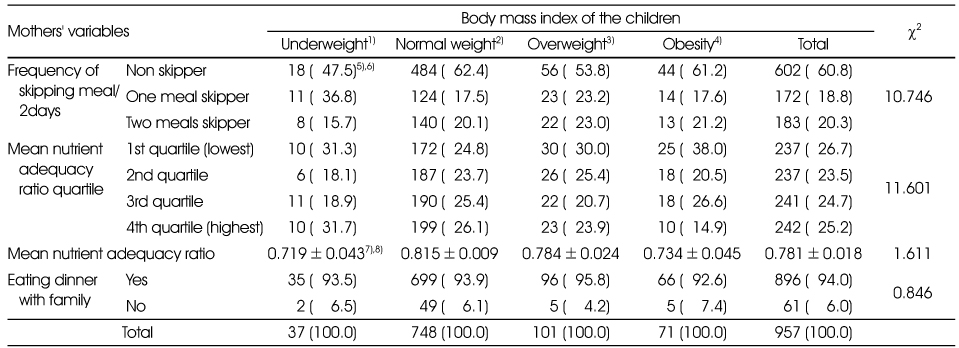
Association between eating habits and nutrition status of mothers and body mass index of the children
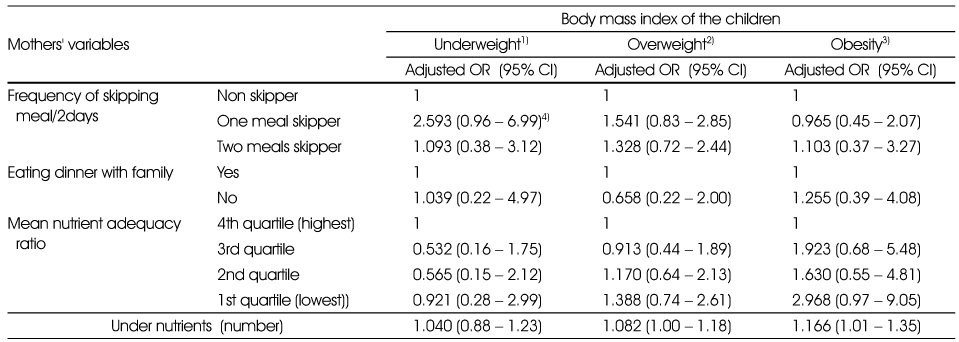
Figure & Data
REFERENCES
Citations

- Relationship between the Dietary Behavior of Young Children and Their Mothers in Daejeon, Korea Using the Nutrition Quotient for Preschoolers and Adults
InYoung Jeong, SuJin Song
Korean Journal of Community Nutrition.2021; 26(1): 12. CrossRef - Exploring parenting variables associated with sweetness preferences and sweets intake of children
Taejung Woo, Kyung-Hea Lee
Nutrition Research and Practice.2019; 13(2): 169. CrossRef - Effect of Dietary Education Experience (Home, School, and Mass Media) on Food Consumer Information literacy
Ji Eun Kim, Kyoung Sook Choi
Korean Journal of Community Nutrition.2019; 24(5): 363. CrossRef - Study on the correlation between nutrition knowledge, dietary attitudes of guardians, and nutritional status of infants and toddlers - Nutrition-Plus program in Jeonju
Eun Young Song, Jeong Ok Rho
Journal of Nutrition and Health.2018; 51(3): 242. CrossRef - Factors Related to Recommended Nutrient Intakes of Young Children and Their Mothers
Jung Mi Kim, Soon Rim Suh
Journal of Health Informatics and Statistics.2018; 43(4): 282. CrossRef - Nutritional status of 3~5 year old children attending kindergarten and childcare facilities: Using data from the 2010 and 2014 Korea National Health and Nutrition Examination Surveys
Mi Yeon Park, Pil Sook Park
Journal of Nutrition and Health.2017; 50(4): 361. CrossRef - Mother's Parenting Style at Meal Time and Their Preschooler's Dietary Behavior
Soyeon Park, Youngmee Lee
Korean Journal of Community Nutrition.2017; 22(1): 13. CrossRef - Factors Affecting the Frequency of Skipping Meals of Prime-Aged Mothers with Children : Data from the Fifth Korea National Health and Nutrition Examination Survey, 2010-2011
Mi-Yeon Park, Pil-Sook Park
Korean Journal of Community Nutrition.2016; 21(5): 451. CrossRef
- We recommend
- Related articles
-
- Trends in growth and nutritional status of Korean toddlers and preschoolers: a cross-sectional study using 2010–2021 Korea National Health and Nutrition Examination Survey data
- Comparative study on the health and dietary habits of Korean male and female adults before and after the coronavirus disease 2019 pandemic: utilizing data from the 8 th Korea National Health and Nutrition Examination Survey (2019–2021)
- Changes in nutritional status of Korean older adults during COVID-19 Pandemic by household income and demographic factors -using the Korea National Health and Nutrition Examination Survey(2019-2020): a cross-sectional study
General characteristics of the children by body mass index
1)BMI <5th percentile, 2)BMI 5th to less than the 85th percentile, 3)BMI 85th to less than the 95th percentile, 4)BMI ≥95th percentile, 5)N (%), 6)Calculated by Complex Samples χ2-test, 7)Mean±SE, 8)Calculated by Complex Samples General Linear Model
**: p < 0.01, ***: p < 0.001
General characteristics of children's neonatal period by body mass index of the children
1)BMI <5th percentile, 2)BMI 5th to less than the 85th percentile, 3)BMI 85th to less than the 95th percentile, 4)BMI ≥95th percentile, 5)N (%), 6)Calculated by Complex Samples χ2-test, 7)Mean±SE, 8)Calculated by Complex Samples General Linear Model
**: p < 0.01, ***: p < 0.001
General characteristics of mothers by body mass index of the children
1)BMI <5th percentile, 2)BMI 5th to less than the 85th percentile, 3)BMI 85th to less than the 95th percentile, 4)BMI ≥95th percentile, 5)N (%), 6)Calculated by Complex Samples χ2-test, 7)Mean±SE, 8)Calculated by Complex Samples General Linear Model
*: p < 0.05, **: p < 0.01
Dietary attitudes and mean nutrient adequacy ratio quartile of mothers by body mass index of the children
1)BMI <5th percentile, 2)BMI 5th to less than the 85th percentile, 3)BMI 85th to less than the 95th percentile, 4)BMI ≥95th percentile, 5)N (%), 6)Calculated by Complex Samples χ2-test, 7)Mean±SE, 8)Calculated by Complex Samples General Linear Model
Association between general characteristics of mothers and body mass index of the children
1)BMI <5th percentile, 2)BMI 85th to less than the 95th percentile, 3)BMI ≥95th percentile 4)Calculated by Complex Samples Logistic Regression Model
Values were adjusted by age, sex, asthma and atopic dermatitis
Association between eating habits and nutrition status of mothers and body mass index of the children
1)BMI <5th percentile, 2)BMI 85th to less than the 95th percentile, 3)BMI ≥95th percentile 4)Calculated by Complex Samples Logistic Regression Model
Values were adjusted by age, sex, asthma and atopic dermatitis
Association between body mass index of mothers, birth weight of the children, and body mass index of the children
1)BMI <5th percentile, 2)BMI 85th to less than the 95th percentile, 3)BMI ≥95th percentile 4)Calculated by Complex Samples Logistic Regression Model
Values were adjusted by age, sex, asthma and atopic dermatitis
1)BMI <5th percentile, 2)BMI 5th to less than the 85th percentile, 3)BMI 85th to less than the 95th percentile, 4)BMI ≥95th percentile, 5)N (%), 6)Calculated by Complex Samples χ2-test, 7)Mean±SE, 8)Calculated by Complex Samples General Linear Model **: p < 0.01, ***: p < 0.001
1)BMI <5th percentile, 2)BMI 5th to less than the 85th percentile, 3)BMI 85th to less than the 95th percentile, 4)BMI ≥95th percentile, 5)N (%), 6)Calculated by Complex Samples χ2-test, 7)Mean±SE, 8)Calculated by Complex Samples General Linear Model **: p < 0.01, ***: p < 0.001
1)BMI <5th percentile, 2)BMI 5th to less than the 85th percentile, 3)BMI 85th to less than the 95th percentile, 4)BMI ≥95th percentile, 5)N (%), 6)Calculated by Complex Samples χ2-test, 7)Mean±SE, 8)Calculated by Complex Samples General Linear Model *: p < 0.05, **: p < 0.01
1)BMI <5th percentile, 2)BMI 5th to less than the 85th percentile, 3)BMI 85th to less than the 95th percentile, 4)BMI ≥95th percentile, 5)N (%), 6)Calculated by Complex Samples χ2-test, 7)Mean±SE, 8)Calculated by Complex Samples General Linear Model
1)BMI <5th percentile, 2)BMI 85th to less than the 95th percentile, 3)BMI ≥95th percentile 4)Calculated by Complex Samples Logistic Regression Model Values were adjusted by age, sex, asthma and atopic dermatitis
1)BMI <5th percentile, 2)BMI 85th to less than the 95th percentile, 3)BMI ≥95th percentile 4)Calculated by Complex Samples Logistic Regression Model Values were adjusted by age, sex, asthma and atopic dermatitis
1)BMI <5th percentile, 2)BMI 85th to less than the 95th percentile, 3)BMI ≥95th percentile 4)Calculated by Complex Samples Logistic Regression Model Values were adjusted by age, sex, asthma and atopic dermatitis

 KSCN
KSCN
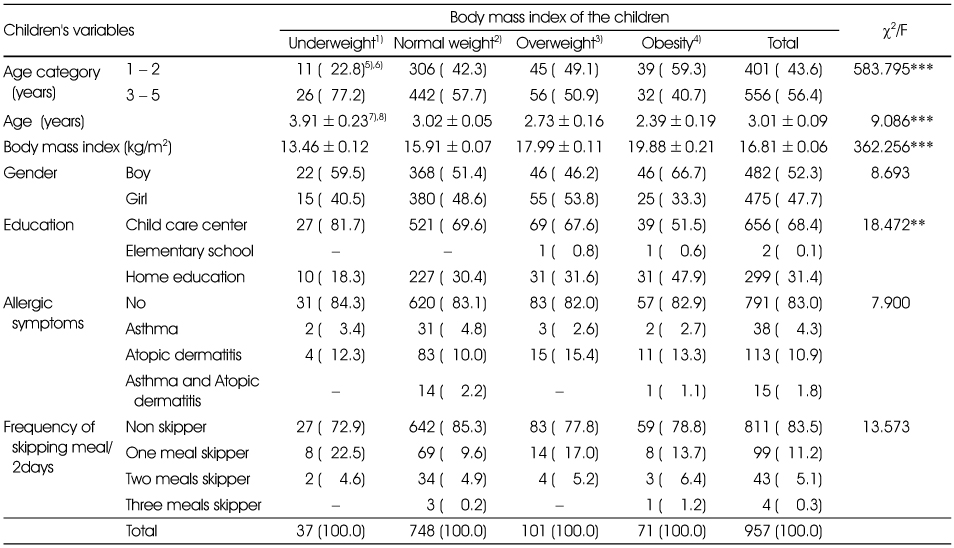
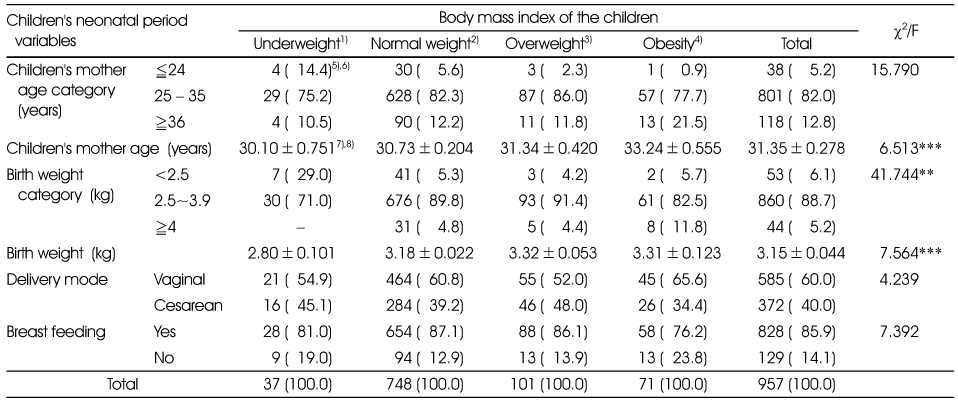
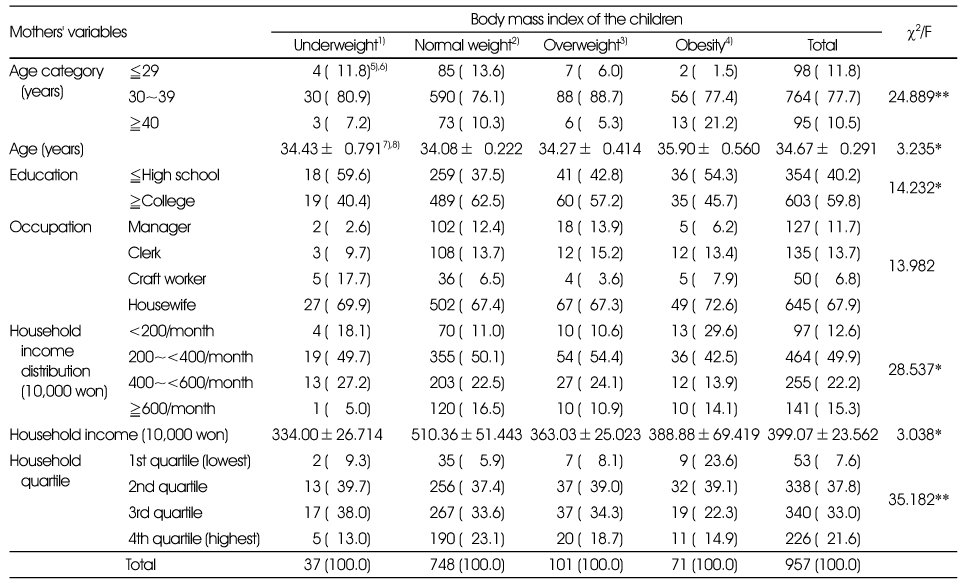
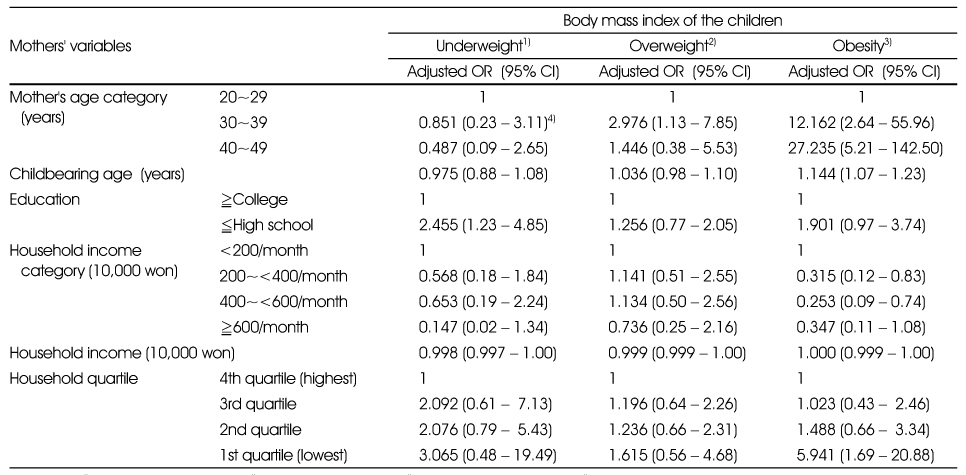

 PubReader
PubReader Cite
Cite


